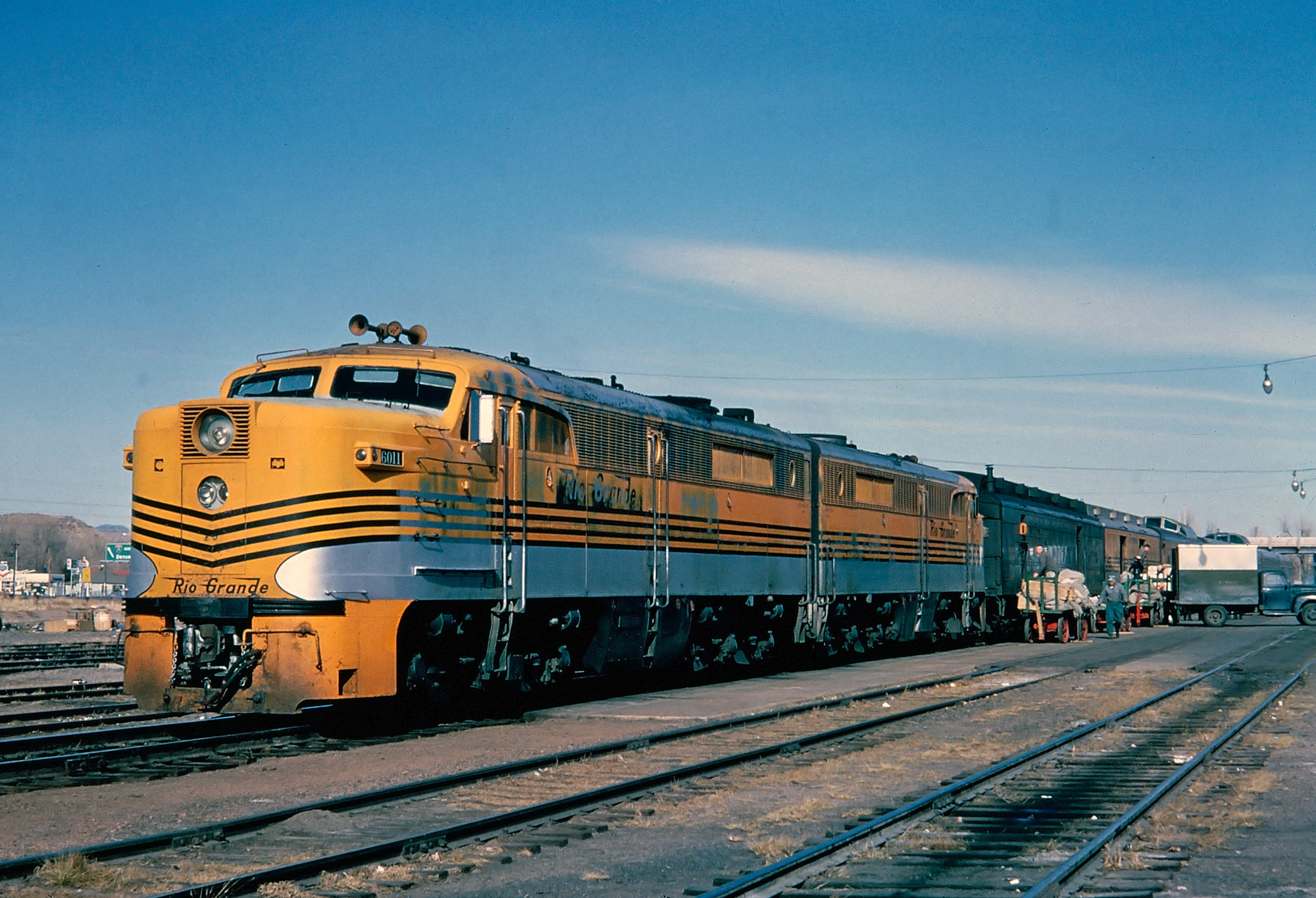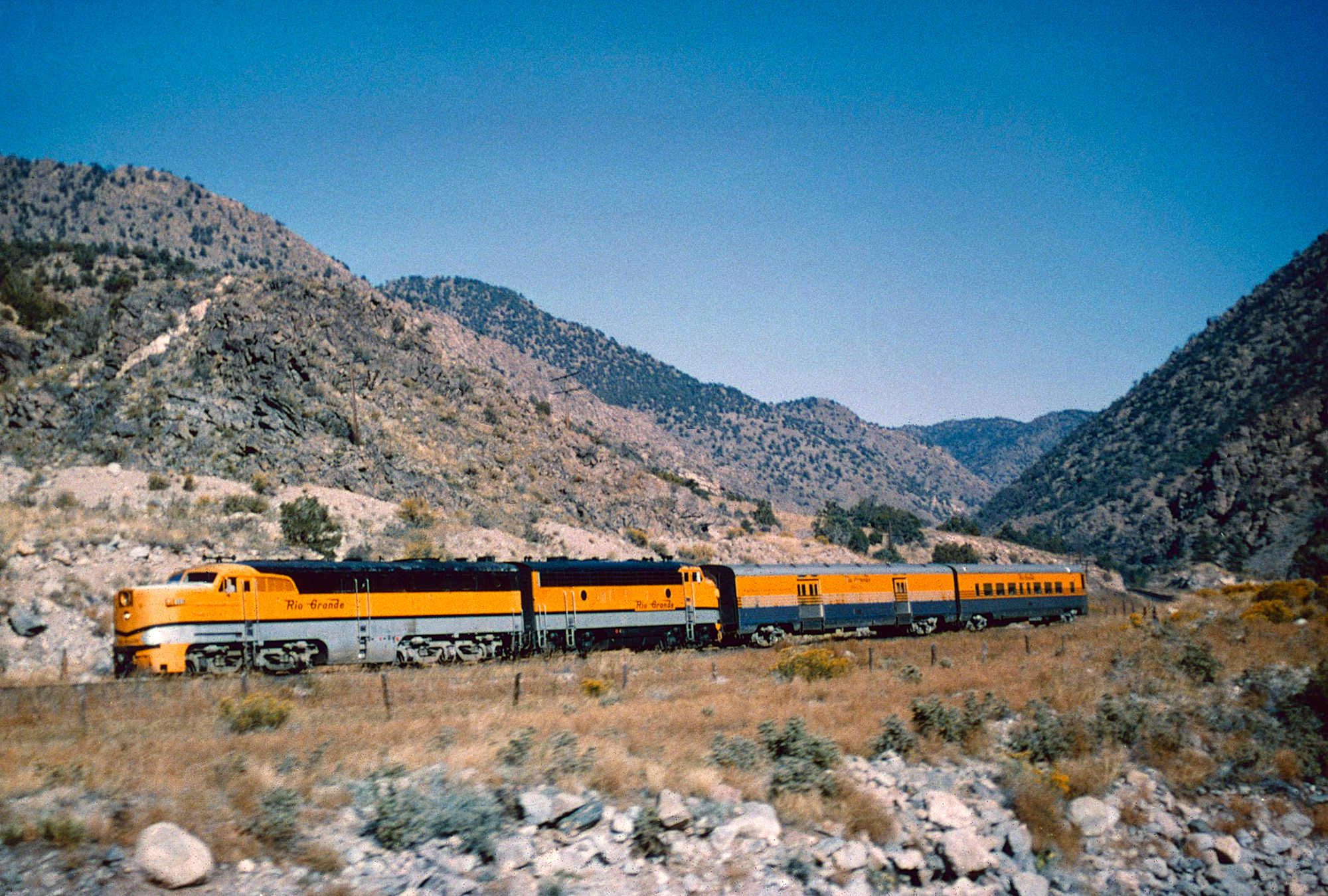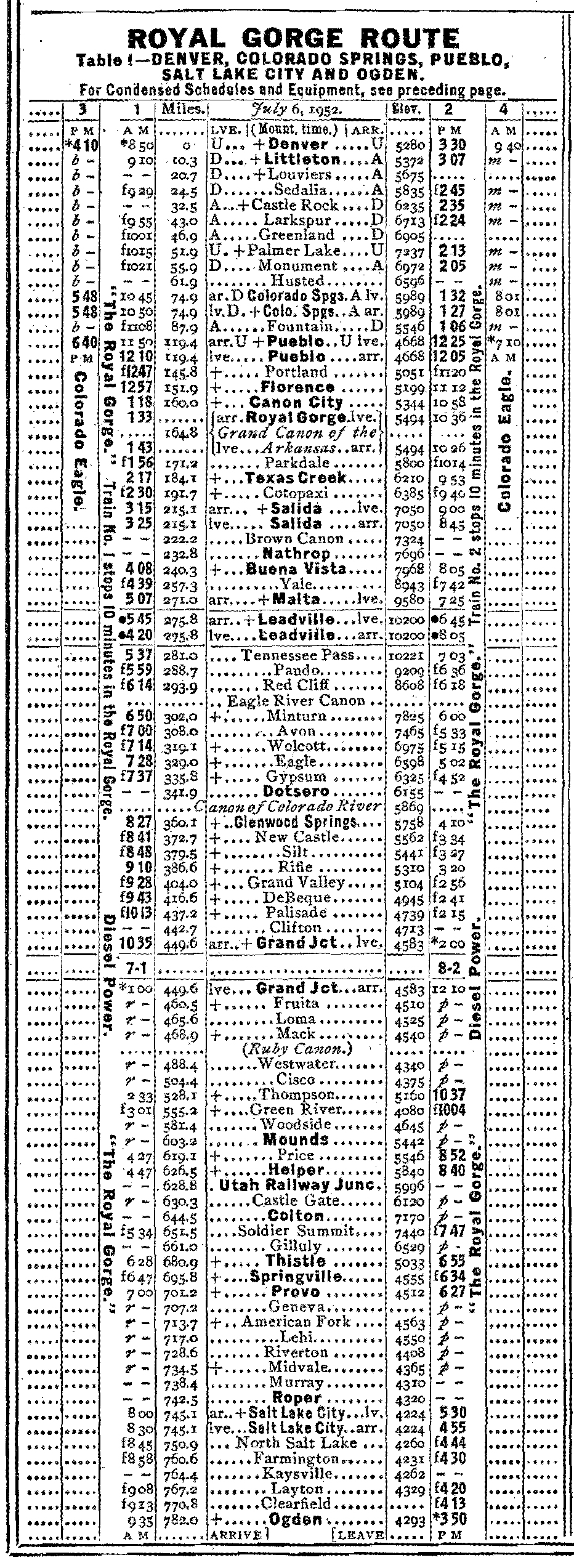The "Royal Gorge": From War To Popular Train
Last revised: September 15, 2024
By: Adam Burns
While trains have traveled through Colorado's stunning Royal Gorge since May, 1879 - during which time two railroads fought for control of this critical region - a train named in its honor was not launched until 1946.
The Denver and Rio Grande Western, a railroad company with roots deeply embedded in American history, has left an indelible mark on the landscape and culture of the American West.
One of its most illustrious services was the Royal Gorge, which connected Denver and Salt Lake City, traversing rugged terrains and showcasing some of the most breathtaking views in the country.
The train, which replaced the Scenic Limited, featured an array of popular services including Pullman sleepers and even domes throughout the 1950s.
As patronage slipped and the railroad cutback its passenger offerings, the Royal Gorge was formally discontinued in 1967. In 1998, the public could once again travel by train through the stunning gorge via the Royal Gorge Route Railroad. Today, it remains a popular tourist attraction.
 Rio Grande's "Royal Gorge" takes on mail at the joint Rock Island/D&RGW depot in Colorado Springs, Colorado on December 31, 1964. American-Rails.com collection.
Rio Grande's "Royal Gorge" takes on mail at the joint Rock Island/D&RGW depot in Colorado Springs, Colorado on December 31, 1964. American-Rails.com collection.Early Beginnings
The Denver & Rio Grande Railway was founded in 1870 by General William Jackson Palmer. Initially conceived as a narrow-gauge line that would serve mining communities in Colorado, the D&RG quickly expanded.
By 1879, the company had set its sights on more ambitious goals: tapping into the booming markets and connecting strategic points across the vast expanses of the West.
In the early 1880s, the D&RG faced stiff competition from the Atchison, Topeka and Santa Fe Railway (AT&SF) for control over the lucrative route through the Royal Gorge, a 10-mile-long canyon of the Arkansas River in Colorado. This intense rivalry led to legal battles and even instances of sabotage, but it was ultimately resolved in the courts in favor of D&RG.
The Construction
Winning the battle for the Royal Gorge was only the beginning. Constructing a railway line through this challenging terrain required immense engineering prowess, audacious planning, and an indomitable will.
The Royal Gorge Route necessitated the construction of the first-ever hanging bridge, a marvel of civil engineering that clung to the canyon walls and hovered over the roaring Arkansas River below. This bridge, completed in 1879, remains one of the key highlights of the journey.
In 1883, the D&RGW extended its narrow-gauge tracks from Pueblo, Colorado, reaching Salt Lake City, and eventually Ogden, Utah, where it connected with the Central Pacific and Southern Pacific Railroads. This extension realized a vital transcontinental link that streamlined the movement of people and goods across the West.
Transition and Modernization
As the 19th century turned into the 20th, the benefits of broad-gauge railways became more apparent. The narrower tracks initially chosen by many Western railroads posed limitations in terms of speed and load capacity.
Between 1888 and 1890, the D&RG underwent a significant transformation, converting its mainline to standard gauge. This change not only allowed for more efficient operations but also positioned the D&RGW for greater integration into the national rail network.
The Royal Gorge Route, now a part of this modernized network, continued to serve as a key artery. It was particularly favored by passengers who wished to experience the stunning beauty of the Rocky Mountains and the intricate landscapes of the Royal Gorge itself.
Golden Age
The early to mid-20th century is often considered the golden age of American railroading, and the Royal Gorge Route was at the heart of it. Luxurious Pullman cars, fine dining services, and panoramic observation decks turned this route into a premier travel experience. The train ran daily, providing an essential link not just for tourists but also for communities along the route.
The Royal Gorge Route was known for punctuality, exceptional service, and its scenic wonders. Marketing campaigns of the era touted the glamour and adventure of train travel, and excursions through the Royal Gorge were often highlighted.
The route's significance extended beyond passenger travel as well, becoming a critical conveyor of freight, especially agricultural products and minerals that were vital to the economy.
In his book, "Rio Grande Railroad," author James Griffin notes the company officially dedicated the Royal Gorge in June, 1946, replacing what was then the Scenic Limited.
The overnight train ran between Denver and Salt Lake City/Ogden via Pueblo and Tennessee Pass. At Pueblo the train would interchange with the Missouri Pacific and picked up a Pullman sleeper running between St. Louis and San Francisco. Here, it also ran with a through coach bound for Alamosa until this was discontinued in 1953.
Timetable (July, 1952)
Consist (July, 1952)
Its early, pre-1950 consist generally included diner/lounge, 10-section/2-compartment/1-drawing room sleeper (Denver-Ogden), and chair/coach cars. In 1949 it received significant upgrade when ex-Chesapeake & Ohio dome-observations were added.
In 1950 it began receiving additional lightweight, streamlined equipment from Pullman. In February of that year it was consolidated with the Prospector west of Grand Junction due to declining through ridership.
During its streamlined era the train generally ran with an RPO, baggage car, either one or more ex-Exposition Flyer heavyweight coaches and/or streamlined coaches, a streamlined buffet/lounge during winter schedulring or heavyweight diner during the summer, and a dome coach. During October, 1956 the Royal Gorge added four through Denver Zephyr cars (Burlington) to Colorado Springs.
Decline and Revival
By the mid-20th century, however, the rise of automobile travel and the advent of commercial aviation began to erode the dominance of railroads in America. Passenger numbers dwindled, and many iconic routes, including the Royal Gorge, struggled to maintain their relevance.
As the D&RGW, like many railroads at the time, shifted its focus more heavily towards freight operations the Royal Gorge was on borrowed time by the 1960s. The train was truncated west of Salida in December, 1964 following the loss of mail contracts and declining ridership.
During its final few years it generally ran with a single baggage and coach. The Denver Zephyr cars were dropped on January 1, 1967 and the Royal Gorge was formally discontinued on July 27, 1967.
 Rio Grande PA-1 #6001 and F7A #5554 have what's left of train #1, the westbound "Royal Gorge," near Texas Creek, Colorado on October 3, 1965. Ed Fulcomer photo. American-Rails.com collection.
Rio Grande PA-1 #6001 and F7A #5554 have what's left of train #1, the westbound "Royal Gorge," near Texas Creek, Colorado on October 3, 1965. Ed Fulcomer photo. American-Rails.com collection.The Modern Era
While the original passenger service ceased, the legacy of the Royal Gorge Route would experience a rebirth in later years.
In 1998, the corridor was revived as a scenic and historic train experience, catering primarily to tourists. The resurrection of this historic route has been met with enthusiasm and reverence for its storied past.
Today's Royal Gorge Route Railroad operates from Cañon City, offering various excursions that allow passengers to relive the experiences of yesteryear while enjoying modern amenities.
This revival underscores the enduring fascination with rail travel and the historical significance of routes like the Royal Gorge. It serves as a living museum, preserving the heritage and pioneering spirit that defined the Denver and Rio Grande Western Railroad.
Conclusion
The Royal Gorge Route is more than just a train journey; it is a testament to the enduring human spirit that conquered formidable natural challenges to forge pathways across the American West.
From its fiercely contested inception through its peak during the golden age of railroading, and its modern-day revival, the Royal Gorge Route remains a cherished chapter in the annals of American rail history.
Recent Articles
-
Florida Railroad Museums: A Complete Guide
Apr 17, 25 04:48 PM
Florida is home to many railroad museums preserving the state's rail heritage, including an organization detailing the great Overseas Railroad. -
Delaware Railroad Museums: A Complete Guide
Apr 17, 25 04:23 PM
Delaware may rank 49th in state size but has a long history with trains. Today, a few museums dot the region. -
Arizona Railroad Museums: A Complete Guide
Apr 16, 25 01:17 PM
Learn about Arizona's rich history with railroads at one of several museums scattered throughout the state. More information about these organizations may be found here.


